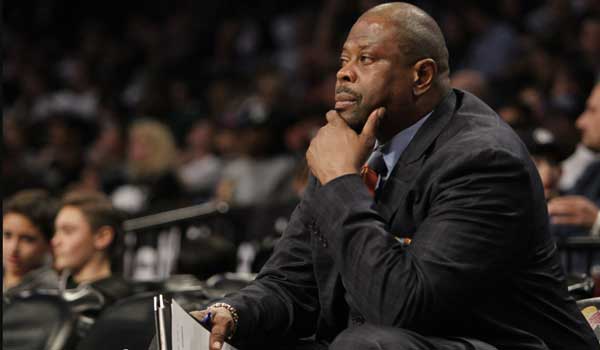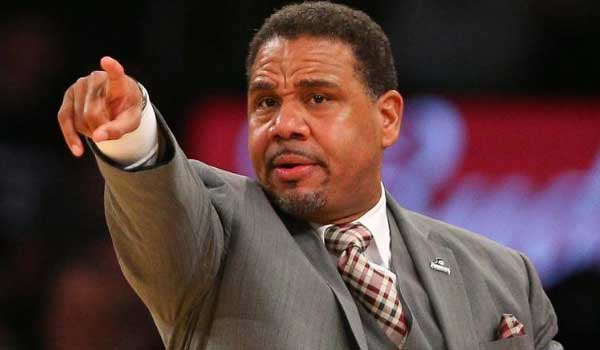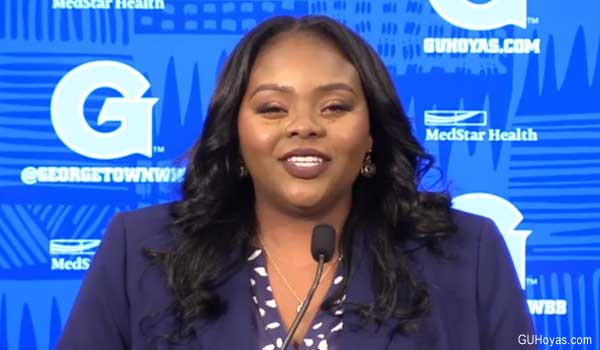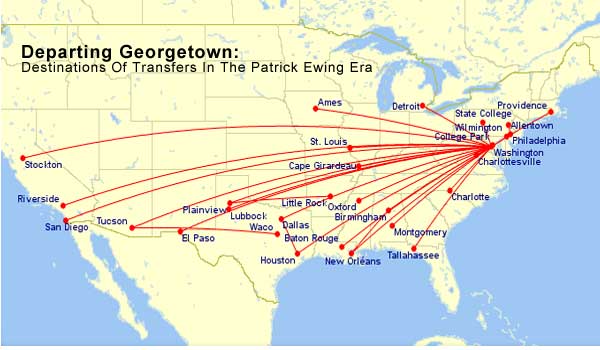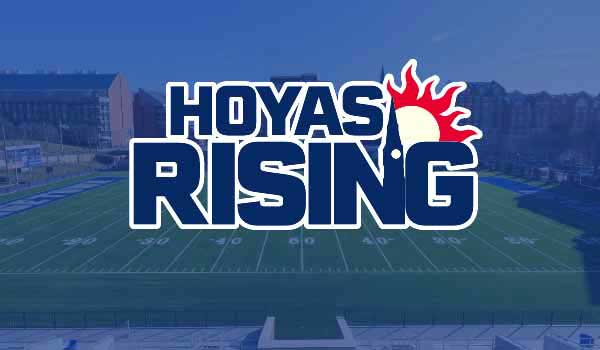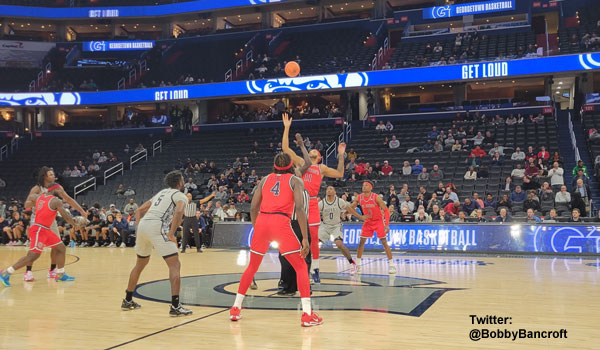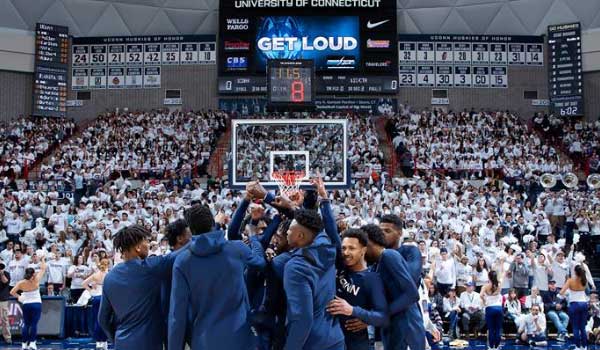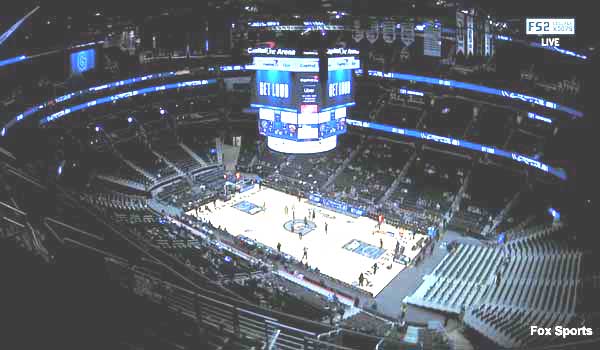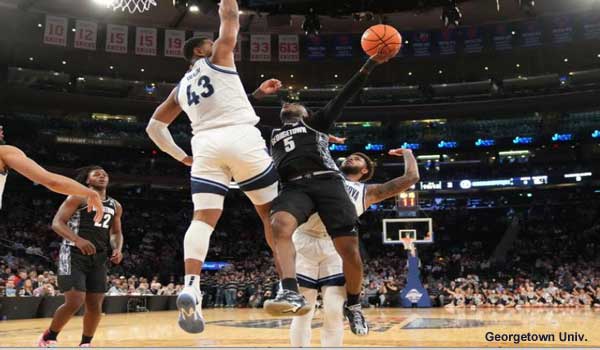Looking Back On 2023It was the most consequential year in Georgetown basketball in over 50 years. Here are the top 10 stories of the past 12 months at HoyaSaxa.com:
In Memoriam: 2023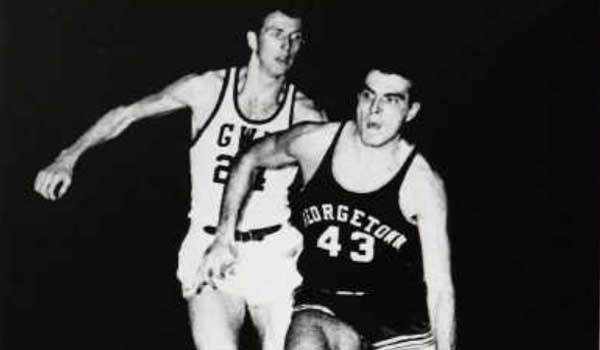 Remembering those members of the extended Georgetown University athletics family that died in 2023:
"F-Minus": Marquette 81, Georgetown 51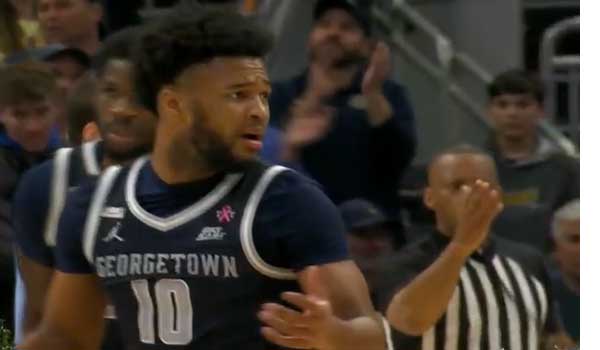
In the last game of a three game, six day Midwestern road tour, few predicted the Georgetown Hoyas to overtake the #6 Marquette Warriors, winners of 22 of its last 23 at home. Still, the lack of effort shown by the team in an 81-51 rout before 16,930 at Fiserv Forum is a point of genuine concern.
POST-GAME ARTICLES
"That was just a bulls#$% performance by Georgetown today," said head coach Ed Cooley.The Hoyas opened the game with a three from Dontrez Styles and led 7-2 just two minutes into the game. Marquette turned up the defense and Georgetown seemed unprepared for the obvious: under pressure it missed six of seven shots, adding a shot clock violation and a 10-second backcourt turnover over the next four minutes. Baskets by Supreme Cook and Drew Fielder give the Hoyas a 13-10 lead at the 12:05 mark of the first half. Then the roof fell in. Poor shooting and mind numbing defensive lapses enveloped this team, as if a ghostly voice yelling "Move!" had suddenly arrived on the bench. The Hoyas missed eight of its next nine allowing the Warriors to shoot seven of its next nine from the field (with two offensive rebounds off the two misses) en route to a 20-2 run, 30-15, at the 6:23 mark. "[Ben] Gold came in and made three threes," Cooley said. "That was game, set, match, and that's something that we spoke about. That's something that we prepared for." Preparation was of little result. Since Styles' opening three, Georgetown had missed its next 11 attempts from long range until the 1:46 mark and gave up seven turnovers. To that point of the first half, Marquette rang out 10 assists on 14 field goals, compared to one assist for Georgetown.
"If we're going to come close to winning any game in this league, a half a game in this league, our defense has to be adjusted," Cooley said in post-game comments. "Right now our defensive mindset is pathetic." Following the Jayden Epps three, the Warriors answered with an uncontested layup and an open three pointer to lead by 17 at the break, 41-24, with Georgetown shooting 31 percent from the field, 2 for 12 from three, and no free throws in the first half. "Today was an F-minus performance. I should give my check back to Georgetown. That's how bad I feel. That's exactly how bad I feel."--Ed CooleyMarquette led by as many as 38 and chose not to empty the bench until the final 1:38 of play. The margin of defeat was the most in the series since a Dec. 27, 1971 game against #2 Marquette, won by the Warriors, 88-44, before 10,746 at the Milwaukee Arena. Entering the final two minutes of tonight's game, that margin was not far out of reach. Where to start? Rowan Brumbaugh is a freshman and he struggled all night against Tyler Kolek, so that was not altogether unexpected. Others seemed tired, distracted, and largely disconnected in the game: Jayden Epps looked more like Primo Spears, hoisting bad three point attempts, failing to distribute the ball, and finishing 5 of 17 with five turnovers. Aside from the two threes, Dontrez Styles disappeared for long stretches of the game and missed seven of his remaining 10 attempts. Ismael Massoud played just six minutes after halftime and was not much of an impediment for Marquette forward David Joplin, who doubled his season average with 20 points and nine rebounds, including four threes. Supreme Cook led all rebounders with 11, though he had just one basket in the final 32 minutes of play, the latter coming with 1:46 to play, down 81-43. For all the individual shortcomings, this was a team effort, and should be noted accordingly. Georgetown gave up 28 points off 18 turnovers, allowed 18 fast break points, and 26 points from layups. Had it not been for the Warriors missing eight of its final nine attempts from three point range in the final 12 minutes of play, this would have been a historic loss. Joplin led all scorers with 20, along with 13 points and 10 assists from Tyler Kolek. Georgetown is 2-12 at Marquette since the 2007-08 season, none more eviscerating than this game. It returns to a familiar seat in the Big East standings: last place. Here's the Georgetown half of the box score:
MIN 2FG 3FG FT REB A PF PTS
Starters:
Brumbaugh 22 0-4 0-1 0-0 4 3 2 0
Epps 37 4-9 1-8 3-4 3 3 2 14
Styles 39 3-6 2-6 0-0 1 0 1 12
Massoud 16 0-0 0-2 0-0 2 0 1 0
Cook 25 3-7 0-0 1-3 11 0 0 7
Reserves:
Montgomery 5 0-0 1-1 0-0 0 0 1 3
Heath 21 1-2 0-4 2-4 4 2 1 4
Fielder 20 3-5 1-2 0-0 4 0 5 9
Mutombo 4 1-2 0-0 0-0 2 0 0 2
Bristol 11 0-1 0-1 0-0 5 0 1 0
Team Rebounds 4
DNP: Asadallah, Bacote, McKenna, Kazor
TOTALS 200 15-36 5-25 6-11 40 8 14 51
Butler 74, Georgetown 64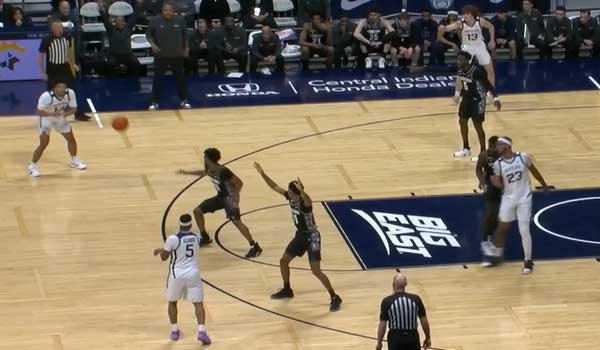 A 13-0 run to close the first half was a knockout punch for the homestanding Butler Bulldogs in a 74-64 win over Georgetown Tuesday at Hinkle Fieldhouse.
POST-GAME ARTICLES
"The better team won today," said coach Ed Cooley in post-game comments. "We were not the team I expected to show up."The Hoyas led for all of 49 seconds of the first half and it was easy to see why: the Hoyas shot poorly and Butler was largely unopposed in the paint. Ten of Butler's first 12 points were inside, and were it not for some strong moves early from Georgetown's Supreme Cook, the Hoyas could have been out of this much earlier. Cook scored six straight midway in the first half to close to 17-14, but he largely disappeared thereafter, shooting just 1 of 3 for the remainder of the game. "He's got to want the ball," Cooley said. Poor shooting never gave Georgetown much chance in this one. Georgetown had no answers other than Cook at this point: Cook was 4 for 5, the rest of the team was a combined 3 for 19. As Cook cooled off, neither team scored for the next two minutes before Butler guard D.J. Davis scored seven straight to put the Bulldogs up eight, 24-16. Another cold streak follows both teams, with Butler shooting 1 for 7 and Georgetown 2 for 11. A returning Jayden Epps scored six straight to bring the Hoyas to two, 27-25, with 3:22 to halftime, but the wheels fell off at this point. Five baskets in the paint and a three from Davis within just 1:54 ballooned the lead to 40-25 before a late Massoud basket closed to 40-27 at halftime. Guards Brumbaugh, Heath, and Epps were a combined 2 for 15 from the floor at the break, and it showed. Were it not for a horrid run of second half outside shooting by the Bulldogs (1 for 9), the outcome would be of no doubt; regardless, Georgetown never made a serious run at the lead. A three pointer from Massoud brought the Hoyas to within ten, 46-36, three minutes into the second half, but back to back Butler layups return the lead to 14. A run of four Georgetown threes within a two minute stretch brought the Hoyas to 60-52 at the 6:54 mark, but Butler answered with a Landon Moore three and a pair of easy layups to go up 15 with 4:52 to play, 67-52. Georgetown closed to 10 at game's end on 4 for 5 shooting but with no impact on the final outcome. Georgetown's interior defense was not even remotely competitive this evening, giving up 46 points in the paint, with 14 second chance points for the Bulldogs, who outrebounded the Hoyas 37-29. Of Butler's 32 missed shots, 15 were returned via offensive rebound. Dontrez Styles led all scorers with 19 before fouling out late in the second half. No one else had a remotely profitable outcome on the stat sheet, with Jayden Epps struggling to a 3 for 10 finish in his first game back in ten days, Rowan Brumbaugh going 3 for 11 and Jay Heath with a season's worst 1 for 8. Of Georgetown's 24 field goals in the game, just eight were by assist. Anything remotely similar to this effort Friday against Marquette won't be close to a 10 point loss. Here's the Georgetown half of the box score:
MIN 2FG 3FG FT REB A PF PTS
Starters:
Brumbaugh 23 3-9 0-2 2-2 2 3 2 8
Heath 29 1-4 0-4 0-0 1 0 1 2
Styles 29 5-9 3-5 0-0 6 1 5 19
Massoud 30 1-1 1-4 2-2 2 3 3 7
Cook 29 5-8 0-0 0-0 7 0 2 10
Reserves:
Montgomery 1 0-0 0-0 0-0 0 0 0 0
Epps 26 2-6 1-4 5-6 2 0 1 12
Fielder 12 0-2 1-2 0-0 2 1 2 3
Mutombo 1 0-0 0-0 0-0 0 0 0 0
Bristol 20 0-1 1-1 0-0 3 0 0 3
Team Rebounds 4
DNP: Asadallah, Bacote, McKenna, Kazor
TOTALS 200 17-40 7-22 9-10 29 8 16 64
McKenna Added To Roster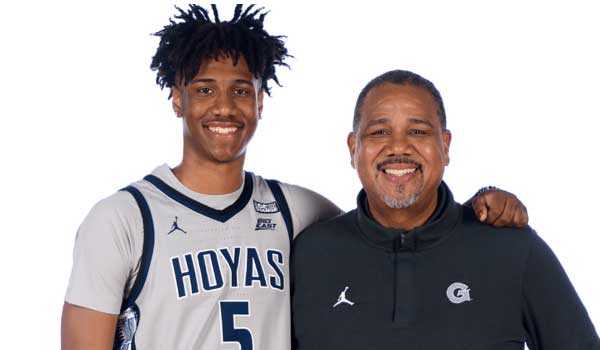 The on-again, off-again story of forward Drew McKenna is back on, with his elevation to the 2023-24 roster.The top ranked recruit from the state of Maryland for the Class of 2024 and ranked 89th among juniors nationally, McKenna committed to Georgetown on May 31 and hoped to reclassify to the Class of 2023, but apparently did not complete his high school graduation requirements in order to enter college in the fall. With his listing after the conclusion of fall semester today, it can be assumed McKenna has graduated, whether through Glenelg Country School or a GED intermediary.McKenna would be the third player to join the Hoyas ahead of his high school class. In December 2008, Hollis Thompson graduated a semester early from Loyola HS in Los Angeles, where he greenshirted the winter 2009 semester and was not elevated to the roster. He then joined the team as a freshman in 2009-10, averaging 8.6 points over three seasons. Three years later, forward Stephen Domingo enrolled at Georgetown a full year early and joined the team immediately, but never matched his prep potential, transferring after averaging just 0.7 points per game in two seasons. Eleven scholarship players and three walk-ons comprise the current roster. Editorial: Georgetown Needs A Plan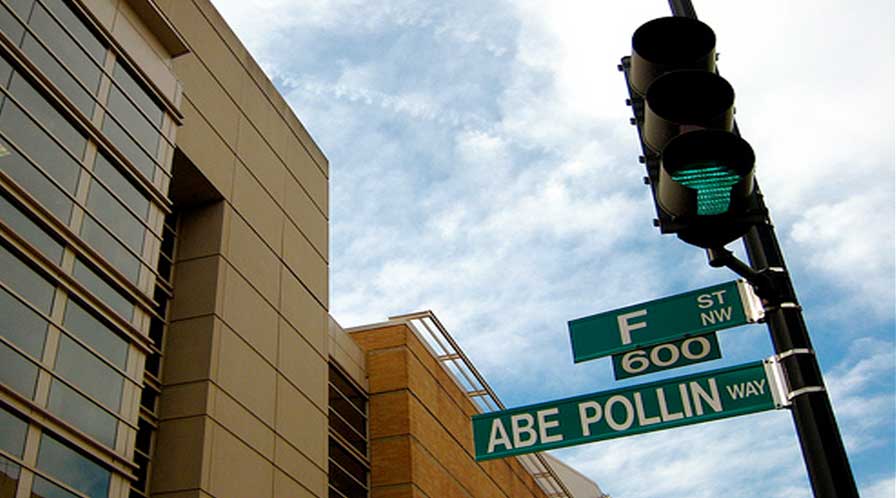 "No plan at all" is where Georgetown University and its basketball program sits right now as to its future for home games after the 2027-28 season, assuming Gov. Youngkin delivers the vote. With a basketball program that has lost 58 percent of its average attendance in the past 12 seasons, and where as much as 80 percent of capacity now goes unsold, it's no stretch to say that the future home of the Hoyas has a lot to say about what kind of program Georgetown can sustain in the years to come.Georgetown can either let whoever owns Monumental Sports and Entertainment in four years call the shots on its basketball future, or take the lead themselves. More...Georgetown 72, Notre Dame 68 (OT)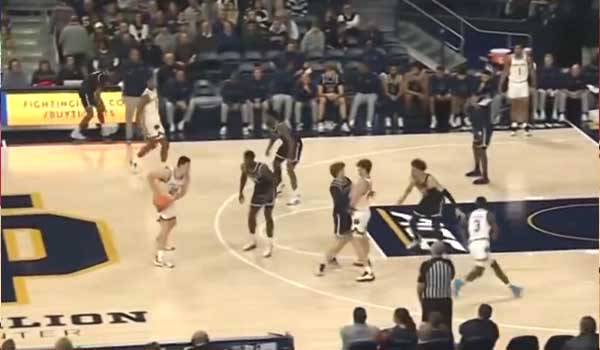
The non-conference portion of the 2023-24 season ended on a hopeful note Saturday, as the Georgetown Hoyas overcame a pair of scoring droughts and upset Notre Dame in overtime, 72-68, before an announced crowd of 7,140 in South Bend, IN.
POST-GAME ARTICLES
The Hoyas began a three game pre-Christmas road trip without leading scorer Jayden Epps, held back on campus due to a lingering illness. Epps' scoring was missed early as the Fighting Irish, shooting 27 percent on the season from there point range, hit two early threes to take an early 8-4 lead. The Hoyas' answer came from a heretofore unlikely source as freshman Drew Fielder scored seven straight over a two minute period early in the first lead of the game, 14-13. A layup from Supreme Cook pushed the lead to 18-13 midway min the first half, but Cook's second foul was a precursor of a lake effect cold snap to befall the Hoyas. Georgetown misses seven consecutive shots over an eight minute period as Notre Dame regained the lead at the 6:10 mark, 23-22, and extended the lead on a 12-4 run to take a nine point lead, 35-26, at the 2:41 mark. The Irish could not hold a lead either, as seven points combined from Jay Heath adn Ismael Massoud closed to 35-33 at the half. Six threes for the Irish led the way in the first half, but Georgetown had eight free throws to just one for Notre Dame at the break. Poor shooting continued to ebb and flow in the second half. With Notre Dame misfiring from outside, Georgetown opened the half on a 16-4 run, with three pointers by Dontrez Styles, Ismael Massoud, and Rowan Brumbaugh to go up 46-39, with a Supreme Cook dunk forty seconds later for an eight point lead, 48-39, five minutes into the second half. This too was fleeting, as a series of miscues opened the door for the homestanding Irish to make a comeback. Off a rebound, Massoud missed a driving layup. On its next three possessions, the Hoyas gave up two turnovers and a shot clock violation. ND responded with a Corey Booth three, a jumper and pair of free throws by Markus Burton, adn five straight by Brandon Shrewsberry to close to 55-51, as Georgetown, shooting 1 for 7, relied on the foul like to stay afloat. A pair of visits at the foul line proved fatal for the Irish. Entering the bonus with 4:56 to play, down thee, center Kenna Njie missed on a pair of free throws, answered by a huge three from Fielder to put the Hoyas up six with 4:34 to play, 58-52. This turned out to be the last Georgetown basket in regulation, as the Irish turned up the defense and climbed back in. Off a defensive rebound, Massoud was picked off by ND's J.R. Konieczny en route to a dunk, 58-54. After an exchange of free throws, a Styles turnover was answered by a Notre Dame layup., 60-58. Jay Heath threw the ball away at the 1:31 mark, whereupon Markus Burton fed Tae Davis for a dunk to tie the score at the 1:26 mark, 60-60. At the foul line with 30 seconds remaining, Heath misses the front end of the one and one, and Burton drives for a layup and the lead with eight seconds remaining, 62-60. A textbook loss common to Georgetown teams of the recent past met with a different ending, however. Instead of panicking or jacking up a three, the ball handling skills of Rowan Brumbaugh was just what Ed Cooley ordered. Brumbaugh saw a crease in Notre Dame's interior defense, drive the lane and picked up a basket with 1.8 seconds remaining to tie the score. There was contact, uncalled, but the points counted and the game was sent to overtime. A three from Styles opened the overtime, but the story of the extra period as ND guard Markus Burton, who scored all six ND points in the overtime and gave th Irish a one point lead, 68-67, with 1:38 to play. Georgetown answered with a Massoud three with 1:16 to play, 70-68.
Fouled with 46 seconds remaining, the foul line was deadly to the Irish yet again. Burton, shooting 4 for 4 from the line, missed both,a and Notre Dame got no close. Off a Brumbaugh miss with 14 seconds to play, a game winning three point attempt was blocked by Supreme Cook, and Brumbaugh finished the game out at the line.
Five Hoyas scored in double figures, with Fielder's 17 leading all scorers. Ten threes for the Hoyas, seven after the halftime break, proved vital in the win, as were 10 more free throws than the Irish, including a +8 in the first half when Georgetown had only two fouls in the first half. Those pair of missed free throws, two late in the second half, two late in overtime, were opportunities lost for Notre Dame. "In these games, it always comes down to a play here or there. They made plays late, we made plays late. We were fortunate to make the best play last," said coach Ed Cooley in post-game remarks. "I saw these two gentlemen up here (Rowan Brumbaugh and Drew Fielder) really grow up today." The two combined for 31 points and a sterling 8 for 8 at the foul line. Saturday's win matched the sum total of wins for last season, seven. It's also Georgetown's first nonconference road win in four years, calling to mind a 91-74 win at SMU on December 5, 2019. A much more difficult road awaits the Hoyas going forward, but the lessons from this game should serve Georgetown well in the battles to come. Here's the Georgetown half of the box score:
MIN 2FG 3FG FT REB A PF PTS
Starters:
Brumbaugh 34 3-5 1-4 6-6 4 3 0 15
Heath 38 2-5 0-3 6-7 6 5 0 10
Styles 44 1-4 2-3 2-4 5 1 2 10
Massoud 39 2-7 3-6 0-0 6 0 3 13
Cook 22 2-6 0-0 2-4 9 1 4 6
Reserves:
Bacote 11 0-0 0-0 0-0 0 3 0 0
Fielder 23 1-2 4-5 2-2 3 0 4 16
Mutombo 2 0-0 0-0 0-0 1 0 0 0
Bristol 11 1-2 0-1 0-0 1 0 2 2
Team Rebounds 4
Injured: Epps
DNP: Asadallah, Montgomery, Kazor
TOTALS 200 12-31 10-22 18-23 39 13 15 72
Two Walk-Ons Leave Team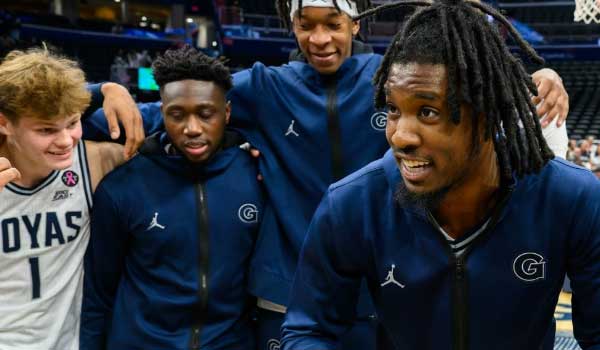
At the end of the final week of the fall semester, walk-ons Victor Muresan and Donovan Grant no longer appear on the varsity roster.No comment was issued by Sports Information or the basketball office.Despite having the same time and practice commitments as their scholarship teammates, no walk-ons have seen any game time since November 15, among them Muresan, a senior in the business school. The 6-11 center from Potomac, MD has played only four minutes over the prior three seasons, failing to score. His last appearance was in the 2022-23 season opener versus Green Bay. Grant's road to Georgetown was more complicated. The 6-6 guard graduated from Campbell HS in Smyrna, GA in 2019, but did not go to college that fall, spending a year at the Atlanta based Skills Factory. Grant signed with Division III NYU in early 2020, but NYU cancelled its 2020-21 season due to COVID-19 and he never played there. Two years later, he walked on at Oregon State but did not see any action as a freshman. Grant played 11 minutes in Georgetown's first three games, with his last game being a two minute stint versus Rutgers. A three point field goal against LeMoyne was his only points this season. Remaining walk-ons include freshman Hashem Asadallah, sophomore Austin Montgomery and graduate student Jonathan Kazor. Leonsis Arena Needs $1.35 Billion Public Subsidy
"A Northern Virginia sports arena that would move the Washington Capitals and Wizards out of downtown D.C. would receive what would be the largest-ever public subsidy for a project of its kind, an estimated $1.35 billion in state and local funds, if it goes forward," writes an article in the Washington Post.The article cites an investment study by JPMorgan for $1.35 billion in direct public subsidy to secure the entire $2.2 billion project. Even with these numbers, an additional $300 million would be needed to complete the overall project."The study does not fully account for who would be on the hook for the full $1.4 billion in debt, saying that the commonwealth and Alexandria would each backstop $560 million of debt," writes the Post. "State and local officials said some details were still being negotiated." In a statement, the governor's office declared that "There is no upfront investment or inclusion of any taxes already being collected by the Commonwealth to repay the bonds and there will be no tax increases for local residents." The JPMorgan study had projected revenue of 17 Georgetown basketball games a year; however, Monumental has already indicated these games will not be held in the building. "Monica Dixon, president of external affairs and chief administrative officer at Monumental, said an agreement regarding Georgetown's future still needed to be worked out." Merchants: Capital One Arena May Not Survive
Despite initial assurances from Monumental Sports that they intend to keep Capital One Arena active after 2028, Washingtonian Magazine reports that some local merchants expect to leave before the arena is shuttered."The news of the Capitals' and Wizards' departure has unleashed some fear that the venue is ultimately doomed," it writes.In an announcement Thursday, the Clyde's Restaurant Group announces it will leave Gallery Place after 28 years if the teams depart. Said the statement: "While we are certainly hopeful that the District can change the trajectory of Penn Quarter such that we would want to continue operating there, it is unlikely that Clyde's would remain at Gallery Place should the teams relocate to Virginia." "The area is going to be kind of a black hole," said restaurateur Daisuke Utagawa, with three properties in the area. "I know they're saying that they're still going to have concerts and so on. But, you know, the regular games are a big, big part of draw to the area." Added one bar owner: "There's no way we would survive if the arena goes away." The Prince Of Potomac Yard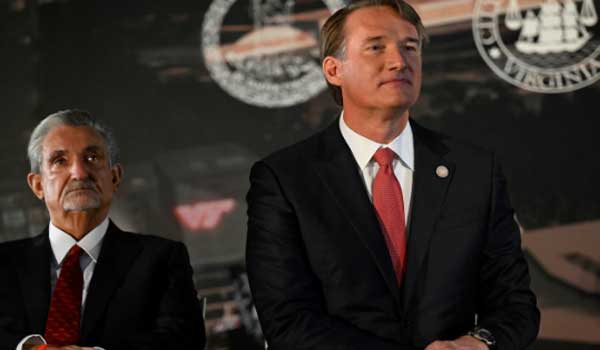
David Aldridge at The Athletic spares no words about the impact of Ted Leonsis leaving town for the revenue potential of a new arena.An excerpt:"Every owner swears that his or her fanbase will follow the team "just down the road" to the new place. The Warriors swore that light rail and express transportation would mean most of their middle-class fans would come from Oakland, across San Francisco Bay, and follow the team to the new Chase Center in downtown San Francisco. They did not. "You have to pay for a $2 billion arena; you don't do so with $15 tickets. You do it with six-figure suites and five-figure courtside seats.""It will be impossible to forget what now feels like [Leonsis'] appropriation of the city's culture, by nicknaming Washington's G-League team the Capital City Go-Go, and centering D.C. at every opportunity , plastering "For the District" and "The District of Columbia" on your Twitter feeds and the jerseys of Wizards players, or hawking this year's alternate jerseys with breathless history about the city's Boundary Stones, or slapping "D.C." on caps and garments , only to walk away from all of that, for the sweetheart deal across the river, your Braves New World. "And if there is any truth to the reporting that Leonsis was irritated by teenage kids performing go-go music, outside of Capital One? Well, it's hard to know how to process that... "I love this city, my city. And my city was wounded, grievously so, Wednesday morning, when men and women on the other side of the river toasted their good fortune, their deal well done, and didn't seem to give a damn about the pain left behind." Read the whole column at The Athletic. Georgetown University: Odd Man Out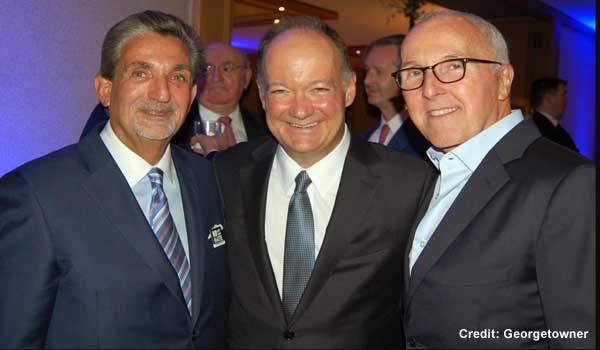
Wednesday's announcement had one glaring omission: the future of Monumental Sports' relationship with Georgetown University.In its press release, Monumental conspicuously does not mention Georgetown basketball in its future plans. "Monumental's goal would be to update Capital One Arena to serve as a unique, flexible arena that could host 10,000-20,000 people and continue to host world-class live entertainment," it noted, a smaller facility that is "maintaining its position as a vital and vibrant point of connection in downtown D.C. Moreover, in the future, the Monumental team would be able to secure more family shows and accommodate annual bookings and mini-residencies that require long-term planning, which is currently not possible with [current schedules]."In a Washington Post Q&A, Svrluga wrote "Monica Dixon, Monumental's president of external affairs and chief administrative officer, told me in an interview late this morning that [it] believes it can fill at least 100 dates annually at Capital One Arena", down from over 200 at present. The move is a tricky one for a University which has committed itself to significant downtown development through its Capital Campus initiative but risks a major downturn in its investment properties should the neighboring Gallery Place area be abandoned. Georgetown basketball has chafed under a long-held contract with arena management dating back to Abe Pollin and the Washington Sports & Entertainment Group that forces all its home games to be played at this facility. The largest arena in the Big East, no home game has sold out Capital One Arena in over 10 years, and last night's attendance, generously listed at 2,924, was a reflection not only of the opponent, but the winnowing Georgetown fan base and a growing lack of ease of fans traveling to the arena at night, where a perception of crime and lawlessness in the Chinatown area has been highlighted by Leonsis in recent articles to support his move. "As we continue to build our organization, we need a lot more support," said coach Ed Cooley in post-game remarks last night. "I would appreciate it if people came out, not so much for who we are playing against but rather to support Georgetown." No comment on the decision was offered from the President's Office at Georgetown nor athletic director Lee Reed following the announcement, mindful of sensitive relations GU maintains not only with the DC mayor's office but Leonsis himself, whose considerable wealth could be of transformational impact in the ongoing University capital campaign, if he chooses to do so. Leonsis is a former member of the Georgetown University Board of Directors, and his son Zach (MBA'15) sits on the advisory board of the McDonough School of Business. Decades of avoiding secondary facility options for the men's program leave the Hoyas' basketball program few good options, while its annual rent payments to Monumental are among the highest anywhere in college basketball. If Capital One Arena is not maintained or is razed, and the program is unable to afford playing in Alexandria, it's a big problem. "We all have reckonings," Leonsis b>has been quoted as saying "They can be small, medium, large or extra-large." However it turns out, consider this one extra-large. Monumental Sports Announces Move Out Of Capital One Arena;
|
Georgetown 71, Coppin State 54
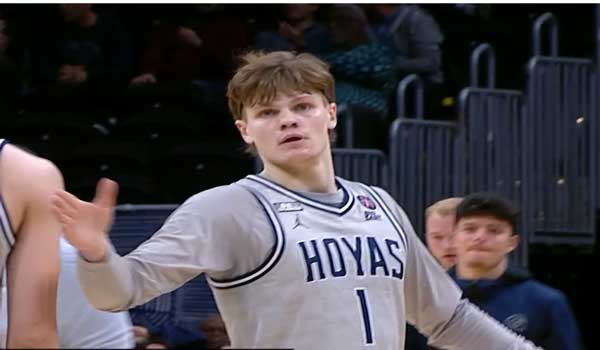
A forgettable exam week game earned the Georgetown Hoyas a 71-54 win over Coppin State Tuesday at Capital One Arena.
Up nine with 1:55 to halftime, Georgetown sank two threes to close out the half, 29-14, its fewest points allowed in almost three seasons. Shooting four of five from three to open the second half, the Hoyas soon led 41-18, with Ismael massoud hitting three from outside after an 0 for 7 first half effort.
The Hoyas got comfortable and its defense took an early holiday. The Eagles responded by shooting 9 for 11 during an eight minute period in the second half to close to 60-47 with 3:37 to play, but all it did was keep coach Ed Cooley from emptying the bench.
From that run of six of seven threes to bookend the first half and open the second, Georgetown went one of eight from outside to end the game and finished 8 for 24 overall.
The game was a win but certainly not the statement it would, could, or should have been against the 361st rated of 362 Division I teams. Georgetown never pulled far enough away to allow coach Cooley to go to the bench, and three starters logged 30 or more minutes against an admittedly outmatched opponent. Here's the Georgetown half of the box score:
MIN 2FG 3FG FT REB A PF PTS
Starters:
Brumbaugh 30 3-4 1-3 5-5 7 4 0 14
Heath 27 1-5 1-4 1-2 5 1 1 6
Styles 32 4-10 3-6 1-2 5 4 0 19
Massoud 31 0-6 3-8 0-0 2 3 2 9
Cook 26 4-8 0-0 1-2 11 0 1 9
Reserves:
Bacote 16 1-1 0-0 0-0 0 2 0 2
Fielder 17 4-7 0-1 3-3 5 2 0 11
Bristol 21 0-0 0-2 1-2 2 2 2 1
Team Rebounds 3
DNP: Asadallah, Grant, Montgomery, Epps,
Mutombo, Kazor, Muresan
TOTALS 200 17-41 8-24 13-16 40 18 6 71
Attendance: 2,924
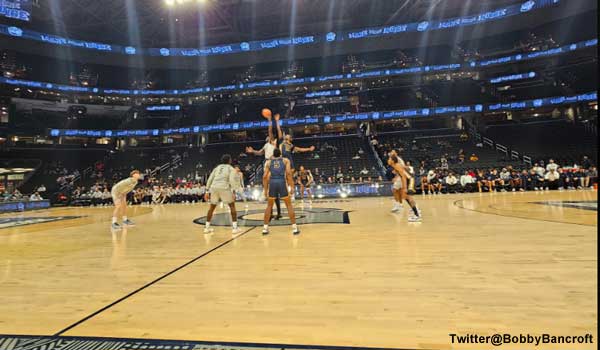
You could see this one coming.
An 8:30 start against a 1-10 team registered an announced attendance of 2,924 to 20,500 seat Capital One Arena Tuesday, the fourth smallest off-campus crowd in school history.Seven of the ten smallest crowds have taken place over the past three seasons.
| Date | Opponent | Location | Attendance |
| 11/30/2021 | Longwood | Capital One Arena | 2,732 |
| 11/29/2023 | Merrimack | Capital One Arena | 2,744 |
| 3/7/2005 | Boston U. (NIT) | MCI Center | 2,797 |
| 12/12/2023 | Coppin St. | Capital One Arena | 2,924 |
| 12/21/1983 | W. Kentucky | Capital Centre | 2,958 |
| 12/8/2021 | UMBC | Capital One Arena | 3,021 |
| 2/22/2023 | St. John's | Capital One Arena | 3,076 |
| 12/5/1984 | St. Leo | Capital Centre | 3,084 |
| 11/23/2022 | American | Capital One Arena | 3,267 |
| 2/1/2022 | Seton Hall | Capital One Arena | 3,462 |
The poor and dispirited attendance did not go unnoticed on the bench.
Virginia Seeks To Move Wizards, Caps Out of D.C.
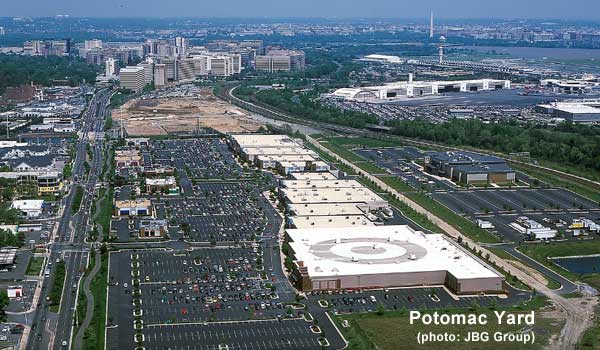
In a potential move the Washington Post predicts would be a "crushing blow to D.C.'s struggling downtown", Virginia officials are green-lighting a plan to persuade Monumental Sports to close Capital One Arena and relocate its pro sports teams to an industrial site in Alexandria by 2027.
The plans come as Monumental Sports seeks $600 million from District officials for a major renovation of Capital One Arena, built in 1997 and 1.8 miles from Georgetown University. By contrast, a new arena, six miles south, could be as much as $1.6 to $1.8 billion in costs, based on current pro sports arena trends, and not counting significant traffic issues in the area, with only one major road (US 1) providing vehicular access. (A Metrorail stop on the Blue and Yellow lines opened near the area in May.)
According to the Post, "a Virginia stadium authority would borrow from Wall Street to pay for the project and pay that money back later. The creation of the stadium authority would allow the developer to leverage state and municipal bond rates, which are well below market rate, to finance construction."
The plan, promoted by incumbent Republican governor Glenn Youngkin, would face scrutiny by Democratic control of both chambers of the General Assembly and neighborhood pushback in the area, a blue-collar area which is seeking to evolve from its days as a railroad yard to a mix of business and multi-family properties."State officials are considering a plan to lower a segment of Route 1...from an elevated highway into a flattened "urban boulevard" and a new arena would be all but certain to add to traffic in an area that already experiences heavy gridlock."
This is not the first effort by the Commonwealth of Virginia to get into the pro sports game. In 1994, the Potomac Yard site was floated as a site for the Washington Redskins but the money was not there and then-owner Jack Kent Cooke opted for FedEx Field in Landover. A bidder for the Montreal Expos proposed a baseball stadium in Pentagon City in 2004, but the Lerner family won the bid and the Nationals built at Navy Yard.
Last year, then-NFL owner Daniel Snyder courted Virginia officials to provide $1 billion in Virginia tax credits to help him build a domed stadium--first in Woodbridge and later Dumfries, 38 miles south of Washington--but both plans collapsed in the General Assembly. Still another plan, now in the conceptual stage, would try to convince current Commanders owner Josh Harris to build a $3 billion replacement for FedEx Field in Sterling, a mere 30 miles northwest of the District.
Georgetown's rental agreement with Monumental Sports is private, but from a previous disclosure, the cost to rent Capital One Arena is a significant annual expense to the University. In a future economic climate, it is not certain that Georgetown would follow the Wizards south.
"I love what's happened to [downtown], but I don't know what's going to happen five, six, seven years from now," Monumental Sports CEO Ted Leonsis said in 2016. "I will be a free agent [then]. I mean, that hasn't been lost on me." The University's close relationship with Leonsis, a 1977 alumnus of the College, a former member of its board of directors, and a potential benefactor to its $3 billion capital campaign, is a further complication.
In a worst-case scenario, Capital One Arena is razed, Georgetown is priced out of a new facility and the athletic department would be left with relocating games to available dates at George Mason University in Fairfax or even the Xfinity Center at College Park, the result of three generations of Georgetown administrations acquiescing to pay tens of millions of dollars in rent over the years rather than commit to a campus-friendly alternative. With a basketball fan following that predominates in Montgomery and Prince George's counties, the scenario of a ticket-buying public that chooses not to travel to Alexandria would further compromise a men's basketball program whose budget is not sustainable by current attendance figures.
In a June 2023 interview at Bloomberg, chief financial officer Peter Biche (B'78) suggested that Monumental may consider a public sale of the company; needless to add, a sale could change the University's relationship with new owners altogether.
For now, though, nothing has changed. In a statement to the Post, DC officials stress that "Mayor Bowser and [D.C. Council] Chairman [Phil] Mendelson have worked together closely, and in lockstep, to put forward a strong proposal to Monumental Sports, and after several months of negotiations, we are committed to seeing this through as a vital component of DC's comeback." A Monumental official would only say that "Our commitment to the DMV is unwavering and we look forward to sharing plans for future investments."
A commitment to the "D" and the "V" are two different things, however.
Syracuse 80, Georgetown 68
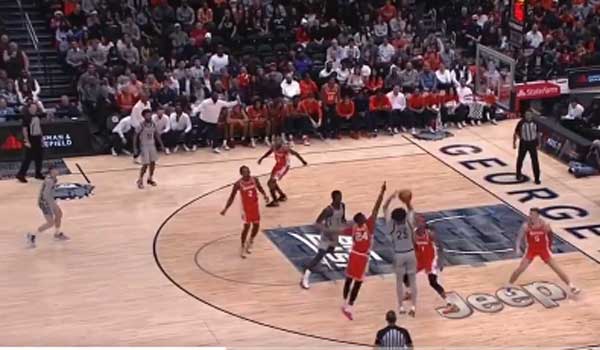
Poor shooting doomed the Georgetown Hoyas in an 80-68 loss to the Syracuse Orangemen Saturday.
Cook's offensive skills were a result of some spotty defense sets by Syracuse but Georgetown was even more deficient inside. The Orangemen closed the half with layups in each of its final three possessions, while Georgetown could do little more than pick up free throws to close to 35-34, shooting 42 percent from the field but a meager 3 for 12 from three point range and allowing SU in an 8-0 advantage on fast break points.
Despite just three points in 14 minutes, the Georgetown offense was ably guided by freshman Rowan Brumbaugh, but when he got into foul trouble late in the first half the offense had no movement and Brumbaugh's fourth foul at the 14:05 mark was a turning point. The Hoyas managed just one field goal over a four minute stretch, going 0 for 3 from there point range and 0 for 4 overall, while Syracuse was 3 for 3 and punched the lead to 54-44 at the 11-23 mark. The Orangemen feasted inside absent Cook's defense, which was often extended to the foul line, leaving reserve forward Quadir Copeland with easy access to the basket. Copeland finished with 14 points, none easier than two layups in 40 seconds to keep its lead at eight, 61-53, with just under nine minutes to play.
A three pointer from Wayne Bristol closed to five, 61-56 at the 8:28 mark, but no closer. Any reasonable outside shooting likely keeps the Hoyas in this game, but there was no spark of shooting. Georgetown missed threes on four consecutive possessions down the stretch and trailed by as many as 16 entering the final minute of play.
"Make no mistake about it: This rivalry is well and alive in both programs. It still means something to both fan bases."
--Adrian Autry, post-game remarks
"I told our men whoever was going to defend was going to win, and I don't think we defended well," said head coach Ed Cooley. "For us to continue to improve we have to hang our hat on defense cause the ball can only be in one basket."
Syracuse got 25 points from Judah Mintz, 13 of those points from the line, along with 21 from J.J. Starling and 14 from Quadir Copeland.
"[Starling] was big," Syracuse coach Adrian Autry commented in post-game remarks. "He stepped up big for us, he controlled the game. He had a moment where he took over the game. And that's what you envision when you got two high-level guards. And today, they played that way."
The Syracuse man defense closed the Hoyas' options outside, and had the Orangemen been more adventurous outside, this could have been a rout. Without Brumbaugh at the point and with Cook's ineffective post play, the Hoyas looked lost all afternoon.
Neither team is making plans for March. The Orangemen are picked 10th in the ACC pre-season poll, and are not expected to contend this season with four ACC teams already ranked among the Top 25 this week. For the Hoyas, the outside shooting will return, but its defensive lapses must be addressed and soon, given the arrival of Big East play in less than 10 days.
Here's the Georgetown half of the box score:
MIN 2FG 3FG FT REB A PF PTS
Starters:
Epps 36 5-8 1-9 4-7 1 3 6 17
Heath 34 1-2 1-5 2-2 2 1 0 7
Styles 37 1-2 0-3 5-5 5 3 0 7
Massoud 31 2-4 1-6 0-0 9 1 1 7
Cook 32 8-10 0-0 0-3 10 3 0 16
Reserves:
Brumbaugh 14 0-1 1-2 0-1 0 4 4 3
Fielder 10 1-2 0-0 0-0 3 1 1 2
Bristol 21 2-4 1-1 2-2 1 1 1 9
Team Rebounds 2
DNP: Asadallah, Grant, Montgomery, Bacote,
Mutombo, Kazor, Muresan
TOTALS 200 20-33 5-26 23-31 33 17 13 68
The Fan Base That Isn't
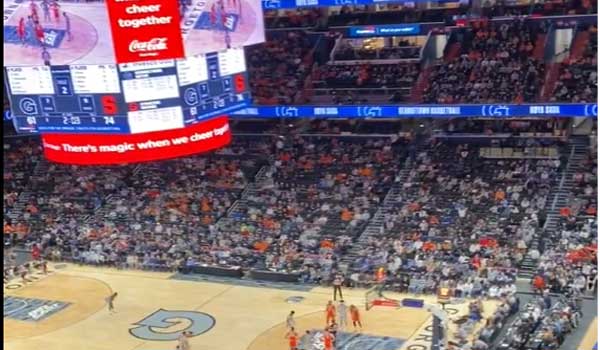
Despite major efforts by the Georgetown ticket office to sell tickets for Saturday's game with Syracuse, fan response was somewhat discouraging.
Announced attendance of 14,193 was slightly less what Georgetown averaged playing Syracuse in the Patrick Ewing era. Students failed to show, filling only one side of the lower bowl and leaving the south end zone empty. A "buy one, bring a friend for $1" promotion failed to draw significant interest.It was kinda awesome pic.twitter.com/T5f9IuzvyS
— Adam Bozzi (@awbozzi) December 9, 2023
Georgetown is heavily dependent on weekend games to drive overall attendance. Only four Saturday home games remain, including a game against DePaul during Christmas break. On a good day, what's left of the the fan base may not be more than 7,000 at this point, and that's an issue Georgetown must address moving forward.
"At the end of the day, no matter how much or how hard Hoya Blue works, or how hard athletics works, it comes down to students deciding to care," sophomore Harrison McCarty told The HOYA. "Hoya Blue can make signs and host tailgates for events all that we want. But at the end of the day, if nobody's showing up, it's not going to do anything to change the culture. So I think what we really need is for students to care and to show up."
And they failed to show Saturday. The posted attendance was the second smallest turnout for a home game downtown between the two schools and the second smallest for any Georgetown-Syracuse game played on a Saturday since at least 1984:
3/3/1984 Sat. Capital Centre 19,035 3/3/1985 Sat. Capital Centre 19,035 1/15/1986 Wed. Capital Centre 18,164 1/31/1987 Sat. Capital Centre 18,744 2/13/1988 Sat. Capital Centre 19,025 2/13/1989 Mon. Capital Centre 19,035 1/27/1990 Sat. Capital Centre 19,035 1/21/1991 Mon. Capital Centre 19,035 1/15/1992 Wed. Capital Centre 15,141 1/5/1993 Tue. Capital Centre 12,185 2/7/1994 Mon. US Air Arena 11,629 1/30/1995 Mon. US Air Arena 16,352 1/24/1996 Wed. US Air Arena 18,753 1/26/1998 Mon. MCI Center 14,408 1/16/1999 Sat. MCI Center 15,983 2/24/2001 Sat. MCI Center 18,189 1/28/2002 Mon. MCI Center 14,889 3/1/2003 Sat. MCI Center 17,352 2/21/2004 Sat. MCI Center 15,389 2/25/2006 Sat. MCI Center 18,879 1/21/2008 Mon. Verizon Center 20,035 1/14/2009 Wed. Verizon Center 19,227 2/18/2010 Thu. Verizon Center 19,976 2/26/2011 Sat. Verizon Center 20,276 3/9/2013 Sat. Verizon Center 20,972 12/5/2015 Sat. Verizon Center 18,231 12/16/2017 Sat. Capital One Arena 15,418 12/14/2019 Sat. Capital One Arena 15,102 12/11/2021 Sat. Capital One Arena 13,598 12/9/2023 Sat. Capital One Arena 14,198
NCAA President Proposes Major Division I Changes
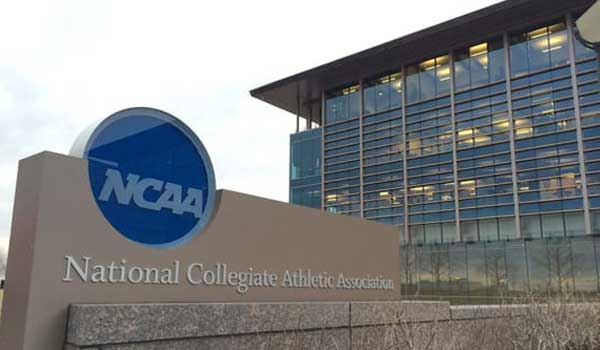
A new subdivision of Division I heavyweights was proposed by NCAA president Charlie Baker on Tuesday.
In a letter send this morning to all 352 NCAA Division I programs, Baker proposed realigning Division I with an upper echelon of schools who would have the authority to pay at least half its athletes a minimum amount of $30,000 annually via an "enhanced educational trust fund"."To deliver on this framework, we need to make several fundamental changes," Baker wrote. "First, we should make it possible for all Division I colleges and universities to offer student-athletes any level of enhanced educational benefits they deem appropriate. Second, rules should change for any Division I school, at their choice, to enter into name, image, and likeness licensing opportunities with their student athletes."
The subdivision would require members at this upper tier to offer this $30,000 based on "eligible" student athletes, which was not defined, but that would be made available to men's and women's athletes per Title IX.
Immediate reaction suggested that the threshold would winnow out much of the the Division I "Group of Five" (American Athletic Conference, Mountain West, Sun Belt, Mid-American, Conference USA) out of the top group, leaving it available for major conferences such as the Big 10, SEC, Big 12, and ACC; however, Baker's approach would require individual schools to opt-in to the subdivision, meaning a school within this new setup could potentially choose not to participate even if their other fellow conference schools do. It could also elevate other schools willing to commit to this amount as a reason to play at a much higher level.
And then what happens? No one knows.
The subdivision would not interrupt championships in other sports, such as basketball, but could affect competitive balance if top-tier conferences are able to offer direct payments to recruits.
"This could result in schools in the new subdivision having no limits on the number of scholarship awarded in a particular sport or sports," suggested USA Today. "At present, Division I schools are subject to sport-by-sport limits on the number of scholarships they can award, and there are some sports with roster limits."
As to the Big East, it appears very unsettled. The conference is not a major conference as defined by football but is rated among the top five conferences in men's basketball. Budget-wise, however, it trails most major conferences and may not be considered one in this alignment.
Baker noted that 59 Division I schools spend over $100 million annually on athletics (no Big East team does) and 32 spend over $50 million (two Big East schools, Connecticut and Villanova, meet this threshold). The other nine Big East schools spend between $28.7 and $49.4 million, while 144 other Division I schools spend less than $25 million, including a number of HBCU's that spend less than $12 million.
"This conversation has to be had," said Sun Belt commissioner Keith Gill. "We've got to create a structure that's sustainable and doesn't have us in court every six months with a new case that has really crushing potential...I think the overall conversation is really important, and I think it's time that we had it."
As to NIL, "I think we've got to figure out a solution," said Georgia president Jere Morehead, who succeeded Georgetown president Jack DeGioia at the helm of the NCAA Board of Governors. "I'm not sure we can solve that at the NCAA level. I think Congress is going to have to be involved in that discussion, but we've got to look for a solution to stories like a transfer quarterback being paid a million dollars to go to another school. That's not what NIL was ever intended to be."
How this might affect Georgetown? For now, it's unlikely.
Baker's plan is a football subdivision within Division I, for which Georgetown would be unable and unwilling to opt into. If the subdivision concept evolves into an all-sports group, there would be pressure to decide whether the Big East would join this group to maintain national prominence in men's basketball and what the impact on other sports would be, particularly those underfunded to major college counterparts. At present, two thirds of all Georgetown sports are not fully funded on scholarship aid, and 12 of the 30 sports operate on few or no scholarships at all. The various side conversations about athlete compensation are speculative unless and until the NCAA actually comes to consensus, which is something it has found difficult to do.
Georgetown University has a powerful advocate for intercollegiate athletics in Jack DeGioia, a former student-athlete himself who has been at the forefront of numerous NCAA reforms over his tenure at that organization's Board of Governors and as a member of the Knight Commission on Intercollegiate Athletics. Most importantly, he understands what works for Georgetown, and what doesn't.
"No longer is the NCAA sitting back," writes Fox Sports.com. "No longer is the NCAA letting others dictate their own business to them, but instead trying to take the bold step of doing it themselves amid an unprecedented era off the field. 'We have to be proactive about thinking about what's coming up next, so we can help the members deal with it,' Baker remarked before distilling what his office's chief charge is moving forward: 'Get stuff done!'"
Sweetney Selected For Athletic Hall of Fame
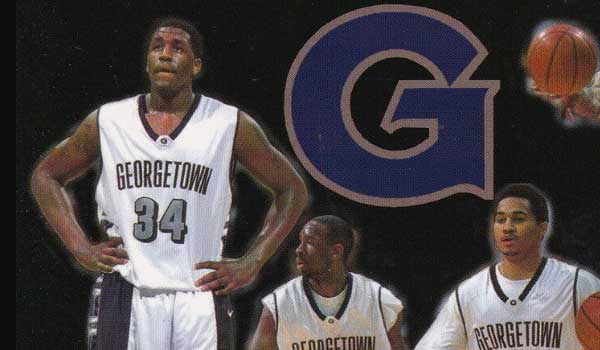
Per an announcement late last week, former All-American Michael Sweetney (2000-2003) has been selected for the Georgetown University Athletic Hall of Fame.
"[In 2002-03], Sweetney led the team in scoring 25 times, never scoring below double figures," wrote the Georgetown Basketball History Project. He led the team in rebounding 29 times, with 16 double figure rebound efforts. Shooting 55 percent from the floor and 74 percent from the line, he accounted for nearly a third of the team's offense that season. Sweetney opened Big East play with 35 points and 19 rebounds in an overtime win versus West Virginia and never let up. His 22.8 per game average trails only Allen Iverson for a single season average, with sterling efforts against Notre Dame (38 points, 15 rebounds), at Syracuse (32 points, 13 rebounds), Pitt (28 points, 8 rebounds), and home versus Syracuse (31 points, 19 rebounds)."
An all-Big East selection, Sweetney was selected to the AP Honorable Mention All-America team in 2003 and was Georgetown's first three-time annual scoring leader since Patrick Ewing (1982-83 through 1984-85).
Sweetney declared for the NBA draft as a junior, and was selected by the New York Knickerbockers with the ninth pick overall. Sweetney battled rapid weight gain and undiagnosed mental health issues following the death of his father, and struggled on the court. The Knicks traded him in just two seasons, and he was out of the league entirely by year four, averaging 6.5 points a game with a weight reported at 390 pounds.
"I just started being really depressed and started gaining weight and things just started going in a bad way," he told the New York Daily News in 2017. "I think at that time, nobody really talked about it. You were looked at as crazy, kind of where now people are talking about depression and things like that. People say depression. Back then, you were crazy. So I was just one thing I was scared to talk about it."
After a career overseas, Sweetney was an assistant coach at Division III Yeshiva College for four seasons.
Mike Sweetney will join former student-athletes Rebekkah Brunson (women's basketball), Elizabeth Delgado (women's soccer), Steve Dusseau (men's lacrosse), Erin Elbe (women's lacrosse), and Chris Lengle (men's swimming) at ceremonies on Friday, February 9.
The 36th men's basketball member of the Hall of Fame, Sweetney becomes the first awardee in men's basketball since 2016, and the first modern era player selected outside the John Thompson era.
Taking The High Road
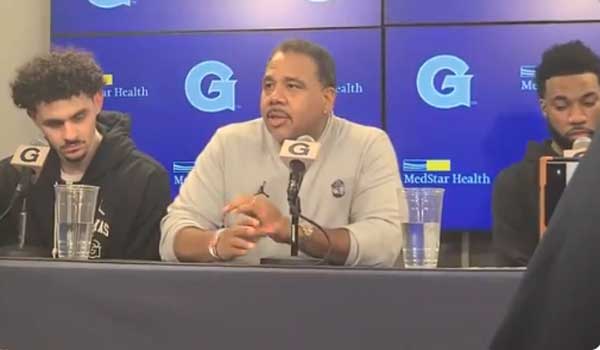
Head coach Ed Cooley had every reason to vent his disapproval at Saturday's finish versus TCU, but wisely chose not to.
"We had three of the best officials in America on our game today: high-level officials, Final Four officials, regional final officials," Cooley said in post-game remarks. "The game is not defined by one play, and that's what everybody is going to talk about. We had opportunities throughout the game. We missed a lot of free throws, missed a couple of blockouts. Everybody's always going to think of the last play, would've, could've, should've. Give [TCU] credit. They had to throw the pass, the kid caught it and made the shot...the rule is what it is."In later comments from ESPN.com, Cooley addressed a review of such contingencies.
"If they can review it to see if he was out-of-bounds and it could be reversed, then I think we do have to take a look at that," he said. "Not because we're on the other side, what's in the best interest of the game. Not so much what's in the best interest of Georgetown at this point. What's in the best interest of the game to keep the game fair, equitable and even across the board.
"If [the official] would have called him out-of-bounds and the ball went in, you can take a look at it and say, well, no basket. You look at it the other way, you can't make the call because there was no call on the floor. Maybe it's an opportunity for us to open up that and take a hard look at it to see if we can do that."
Ed Cooley's thoughts on the officials tonight pic.twitter.com/VxoASxp1tw
— Bobby Bancroft (@BobbyBancroft) December 3, 2023
Texas Christian 84, Georgetown 83
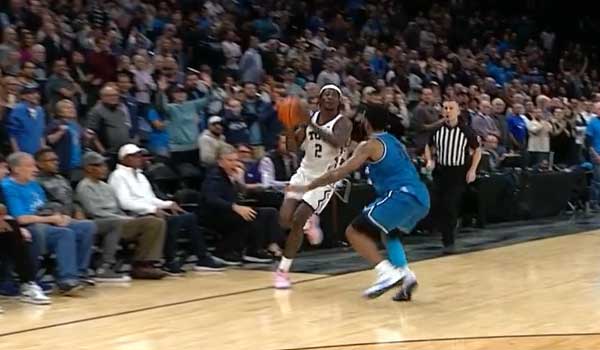
Emanuel Miller's twisting three pointer with no time remaining led TCU to an 84-83 win at Capital One Arena, despite two (count them: two) missed official calls in the final 2.7 seconds that cost Georgetown a much deserved win.
TCU turned up the defense and Georgetown felt the pressure. After giving up just one turnover in its first seven minutes, the Hoyas coughed it up four times in the next 3:18, a 16-4 run that gave the Frogs a 31-27 lead, going four of five from the field, three layups and a dunk.
A Dontrez Styles basket 35-33 with 3:29 to halftime was Georgetown's last of the half, as TCU tuned on te jets with thee layups and a there pointer to take a 44-36 leads at the break, shooting 51 percent from the field, outscoring GU 12 to 1 on points off turnovers, 28 to 12 on points in the paint, and 12 to 3 in fast break points, despite Georgetown shooting 44 percent at the break with five threes of its own.
TCU continued the hot hand to open the second, scoring the first three baskets of the game untouched in 1:19 and leading by 14, 50-36. Georgetown was down 11 at the 16 minute media time out when Ismael Massoud began a legendary second half comeback.
Massoud, in his second game as a Hoya coming off injury, was 0 for 5 in the first half when his three pointer with 15:03 mark began the Hoyas' run. As the TCU offense stalled, the Hoyas picked up the pace on its own, getting six straight from Jayden Epps to close to 59-56 at the 12:27 mark when Massoud hit a three to close to one at the 11:42 mark and another three with 8:06 to play to give the Hoyas a 67-66 lead.
Following an exchange of free throws, Massoud's three with 4:44, his fourth in an 11 minute run, extended Georgetown's lead to five, 77-72, but it would be Georgetown's last field goal of the game. TCU, shooting one for eight from three point range, answered with a Trevian Tennyson there, 77-75, with 4:27 to play, and the race to a wild and controversial finish was on.
The two teams traded misses on its next four possessions before Massoud added two free throws at the 2:18 mark, 79-75. After Epps blocked a layup from TCU's Avery Anderson, Epps added two more at the line, 81-75. On TCU's next series, Jameer Nelson Jr. went deep on a three, 81-78. As the Hoyas were pressed bringing the ball up the court for the first time in the game, Massoud pushed a TCU defender off the ball and the Hoyas turned over the ball on the player control foul, which was answered by a JaKobe Coles three with 1:29 to play, 81-81.
Georgetown's next series resulted in a miss from Jay Heath, but Massoud stepped up yet again when he blocked an interior shot from Miller on the next possession with 32 seconds to play. On GU's last series, Epps was fouled going to the basket with two seconds to play, hitting both free throws, 83-81.
TCU took over with 2.7 seconds and no time outs remaining.
.@EmanMiller5 at the buzzer for the win!!!!!#GoFrogs pic.twitter.com/QFR0aiC3GH
— TCU Men's Basketball (@TCUBasketball) December 3, 2023
The wild finish was immediately subject to an inconvenient truth, noted by the Fox Sports announcers and confirmed by the TCU radio broadcasters courtside: Miller had stepped out of bounds before taking the shot. (Also missed by the officials: TCU's Micah Peavy stepped inbounds before releasing the pass to Miller.) The officials crew of Mike Roberts, Kipp Kissinger, Ray Natili ultimately passed the buck and fell back on the NCAA rule book, noting that an out of bounds play is not reviewable unless actually called during the game.
Because none of the officials were looking.
Georgetown finished the game shooting 45 percent from the field with 12 threes, although its early free throw struggles contributed to 23 for 31 overall. TCU finished with 52 percent shooting and, no matter the stench of the outcome, deserves the credit by three consecutive threes over the final 1:39 of play. Emanuel Miller, the source of the game winning shot despite his errant left foot, led all scorers with 29 points.
Here's the Georgetown half of the box score:
MIN 2FG 3FG FT REB A PF PTS
Starters:
Epps 36 8-11 1-3 5-7 4 5 2 24
Heath 34 0-1 3-5 1-2 2 2 3 10
Bristol 14 0-0 0-0 0-0 0 0 1 0
Styles 37 2-8 3-6 5-6 6 0 1 18
Cook 32 1-3 0-0 6-8 5 0 2 8
Reserves:
Brumbaugh 7 0-1 0-0 2-3 1 3 1 2
Fielder 8 1-1 1-1 0-1 0 0 1 5
Massoud 31 0-3 4-10 4-4 10 1 4 16
Team Rebounds 3
DNP: Asadallah, Montgomery, Bacote, Mutombo,
Kazor, Muresan
Unavailable: Grant
TOTALS 200 12-28 12-25 23-31 31 11 15 83
Jack VIII Announced By University

Georgetown University has announced an successor to the Jack the Bulldog mascot, a four month old pup who will debut early next year.
"We are excited to welcome our new mascot, Jack, to our university community," said Alumni Association executive director Julia Farr (C'88) in a University news release. "Jack has been getting ready to join his fellow Hoyas for several weeks, learning all the important parts of his role like walks in the neighborhood, playing with new friends and jumping on a skateboard for a ride. He will bring to life our Spirit of Georgetown in all he does here on campus."The 30 pound dog is officially titled "Serchell's John P. Carroll" but will otherwise be known as Jack, the eighth such named dog since 1962 and the the sixth since bulldogs returned to campus a quarter century ago. His predecessor, Jack VII, died unexpectedly last year at the age of four following an intestinal disorder.
